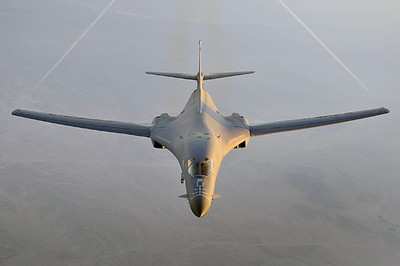The Non-Nuclear Lancer Has Shifted To Close-Air Support
The non-nuclear B-1 Lancer has adapted from a strategic mission
to a close-air support role, and will continue to play an effective
part in today's fight in Afghanistan and Iraq, according to leaders
at Texas' Dyess AFB. While the remaining bombers in the Air
Force inventory transferred to Air Force Global Strike Command, the
B-1 has become the go-to airframe when combatant commanders want a
show of force or support for ground troops.

"The predominance of what we are doing right now in theater is
close-air support; non-traditional intelligence, surveillance and
reconnaissance; and armed overwatch" said Col. Charlie Catoe, 7th
Operations Group commander. "We are supporting the troops on the
ground. The B-1's very flexible. What makes us very useful in the
current fight is that we have a large payload, we can carry a
varied amount of weapons. If you need to go kinetic, you have a lot
of choices on what you can do."
Operating at approximately 20,000 feet, the B-1 waits or
"loiters" with up to 35 tons of precision-guided weapons. When
ground troops encounter the enemy, the bomber's aircrew can engage
in minutes because of the B-1's readiness and speed. "We're fast
for what you might think a bomber can do," the colonel said. "The
loiter time is exceptional so we don't require as much tanker time
to stay and hang around over the fight. Afghanistan is a good-sized
country and we can dash back and forth across it as we need to, if
somebody needs help in a hurry."
When the Lancer flies low and fast over enemy combatants in a
show of force, the 200,000-pound aircraft can intimidate the enemy
handily. Since the airframe continues to play an important role,
Air Force and Air Combat Command officials are looking at ways to
improve the venerable B-1. "We've been in constant upgrade on
numerous systems; the airplane never sits still," Colonel Catoe
said. "There are structural improvements that are going on as the
airframe is not getting any younger."
Colonel Catoe said that the Sniper advanced targeting pod
recently was added to the B-1 at the request of combatant
commanders in the U.S. Central Command area of responsibility. It's
another sensor that has improved the utility of the aircraft. Now
with this tool, it's not a matter of the pilot sending a precision
weapon to an area; the Sniper ATP can enable the pilot to put the
weapon at the correct address, Colonel Catoe said.

Lancer With Sniper Targeting Pod
As the B-1 nears its 25th anniversary, a new chapter could be
opening up for the bomber with an even more precise weapon, the
airborne laser. The Air Force's chief scientist, Dr. Werner Dahm,
flew on a Lancer recently to see if the crew could operate an
airborne laser platform in the tightly spaced cockpit while
continuing to do their duties. The laser is capable of precision
targeting and minimizes unintended damage when the enemy places
hostile networks near schools and mosques. The Lancer could be
looking at a prototype laser by 2014. "All of the new things that
the B-1 is improving or changing are brought here to be tested and
developed. And we also have the weapons school people who work the
tactical end of it," Colonel Catoe said.
The "Home of the B-1" is how Colonel Catoe refers to Dyess Air
Force Base as units here train, equip and field people and weapons
for the B-1. Dyess is host to a schoolhouse and a combat unit.
School instructors train new pilots from undergraduate pilot
training and weapon system officers from undergraduate navigator
training and qualify them in the B-1. Then they are assigned to
combat units at Ellsworth AFB, SD, or here at Dyess.
"Whether flying or maintaining, or on the ground interacting
with our Army brothers, there's an awful lot of great Airmen doing
a great job," Colonel Catoe said.
 Airborne 05.10.24: Icon Auction, Drunk MedEvac Pilot, Bell ALFA
Airborne 05.10.24: Icon Auction, Drunk MedEvac Pilot, Bell ALFA ANN's Daily Aero-Term (05.13.24): ILS PRM Approach
ANN's Daily Aero-Term (05.13.24): ILS PRM Approach ANN's Daily Aero-Linx (05.13.24)
ANN's Daily Aero-Linx (05.13.24) Airborne-NextGen 05.07.24: AI-Piloted F-16, AgEagle, 1st 2 WorldView Sats
Airborne-NextGen 05.07.24: AI-Piloted F-16, AgEagle, 1st 2 WorldView Sats Airborne 05.08.24: Denali Update, Dad-Daughter Gyro, Lake SAIB
Airborne 05.08.24: Denali Update, Dad-Daughter Gyro, Lake SAIB




